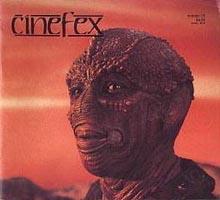Enemy Mine comes to Blu
Some film reviews come out naturally and are written in relatively short time, whereas other require more editing time because either the version that materialized was too long & windy (which of course is completely rare, if not statistically impossible), or there were many specific points that needed some elaboration (which is strikingly different from outright blather).
Then there are films that just don’t work, but the reasons for their flaws also mandate some rest time to figure out why they just don’t click for most, but strangely click for some. Enemy Mine [M] (1985) is pretty much a cult film – a dud when released in spite of a vocal fan base who’s been waiting for a special edition for years.
I never managed to catch the film in theatres or video, so it was kind of exciting to check out what can best be described as The Deeply Flawed Film. In the end, I didn’t care for it, and will never be one of its converts, but it has its place within sci-fi as an unusual attempt to inject a humanist story within a pulp framework and filmmaking style.
The good: Twilight Time’s new Blu-ray looks & sounds great. The disappointing: Fox clearly never felt the need to mount any kind of special edition, so while fans can relish the film in HD, there’s still a void for all those contextual extras.
If the Blu sells out, and if the rights are picked up again for a second try, maybe it’ll happen. The problem is actors and directors get older, memories get fuzzy, surviving publicity and production ephemera get lost, and it becomes harder to pay tribute to a film that’s now getting close to 30 years old. This isn’t to say it’ll never happen, but we know how Special Features Producers have to stretch testimonies and tangible relics from a production when the available sources and surviving materials are few.
A movie made in 1985 and later discovered on TV and home video means there’s a generation or three accustomed to special editions, so it behooves (first time I ever used that antiquated word) labels to go for the definitive edition, much in the way Shout! Factory’s been doing for a bevy for cult movies (especially the Roger Corman and recent John Carpenter films). Twilight Time’s Blu sports an isolated score track, so fans can see how Maurice Jarre shaped his score around specific dramatic peaks.
Suggestions for the ultimate SE: the obvious making-of doc featuring interviews including comments from original director Richard Loncraine and the cast discussing the first version that was aborted by Fox, Barry Longyear’s novella in PDF form, the two differing shooting scripts, promotion and publicity ephemera, Cinefex article by Janine Pourroy, and an edited Criterion-style commentary track featuring thoughts from the filmmakers, writers, production designer, make-up designer Chris Walas, and sci-fi film historians.
As for the fans’ hope of seeing some kind of reconstructed Loncraine cut, that’s likely an impossibility beyond some brief efforts within a comparative featurette. If Loncraine never gave editing notes, there’s no way of knowing how to piece it together scenes beyond guestimation. If there’s no surviving location sound of the dialogue scenes, you have no sound. And given Loncraine didn’t shoot enough to finish the film, you have no completable movie.
A perfect example of what happens when ‘something’ is crafted with raw footage is Something’s Got to Give (1962), Marilyn Monroe’s last film. She was fired early into production, the film wasn’t finished, and the footage was decades later assembled into a small group of functional scenes with stock music which give an impression of what the film may have been, but at roughly a half hour, it’s really just a curio, if not an experiment. A ‘What if…’ that appeases fans wanting some kind of peek at what could’ve been.
Even if Loncraine shot enough for a patchy 60 minute cut, you still have a huge amount of post-production work that needs to be done in addition to figuring out the sound and visual effects. Yes, Warner Home Video funded Richard Donner’s edit of Superman II, but it was done within a tight budget, it had post-production limits that limited Donner from making the effects shine, and most important: there was enough footage for a functional film.
It was also in Warner’s interest to make sure what was delivered was sellable, so it had to be a finished movie in HD. Lastly: Warner didn’t fire Donner, the producers – the Salkinds – did, and most studios are reluctant to mount a reconstruction of a film using the director they fired, even as an editorial consultant. The only people who know whether it’s possible to create an alternate version using the Loncraine and Petersen footage are the few who’ve seen the footage, and that requires a lot of logging just to form a paper edit.
It’s not impossible, but it’s rare when a wholly alternate version – as opposed to an alternate scene / an alternate ending / a rejected score mix – appears on video.
Coming next: Canada’s Top Ten of 2012 on home video.
.
.
Mark R. Hasan, Editor
KQEK.com ( Main Site / Mobile Site )
Category: EDITOR'S BLOG, FILM REVIEWS
















Connect